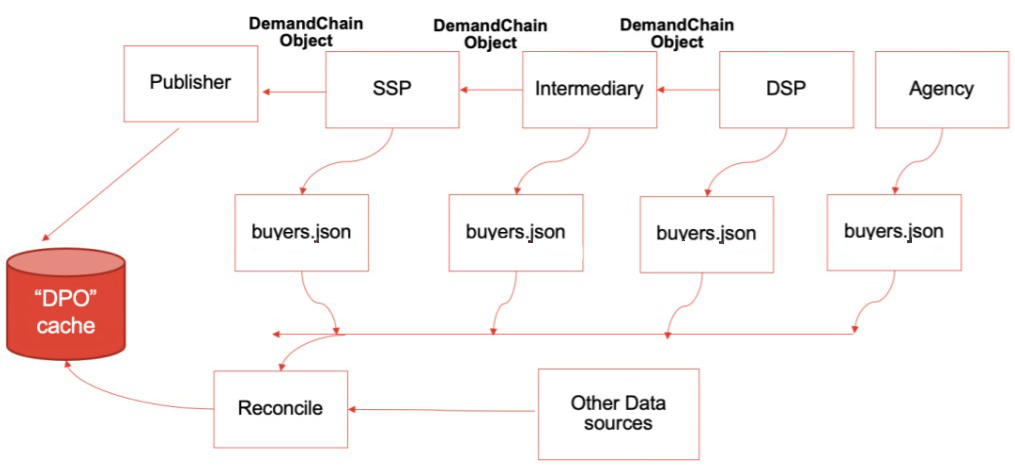IAB Tech Lab have recently launched two new buy-side programmatic transparency standards to replicate the sell-side transparency standards that have been so successful in enabling DSPs and buyers to verify supply sources and interrogate all the intermediaries involved in delivering any inventory offered in bid requests.
Meet buyers.json and the DemandChain object
Called buyers.json and DemandChain object, these standards work by providing transparency into any of the entities involved with publishing low quality ads.
Buyers.json is a mechanism for advertising systems and other intermediaries to publicly declare to sellers any of the buyers that they represent. With this information, publishers and SSPs can easily identify sources of malvertising attacks, identify problematic buyers across multiple demand sources, and take appropriate action to protect themselves and their users.
DemandChain Object enables sellers to see all parties involved in buying the creative embedded in any given bid response and this information can be used to help combat fraud and invalid traffic.

The intentions of these new standards are to protect ad sellers and their site & app visitors from malvertising and quality violations – and provide the building blocks for better demand path optimisation. Malvertisers compete with legitimate advertisers for publisher inventory and negatively impact consumers experiences with digital advertising generally.
What are the benefits for the industry of these Transparency Standards?
The core overall benefit of the industry committing to these standards is to establish better trust and collaboration through improved transparency. This can be achieved through:
Minimising opacity – to stop the unhelpful dialogue regarding ‘murkiness’ and focus instead on value, creativity and innovation. With widespread adoption, the majority of programmatic trading activity will not require too much continuous monitoring. If there are still pockets of irresponsible rogue trading that remain then the tools are now more fully available to interrogate and resolve these issues.
Maximising operational efficiencies – by more competently supporting and enabling both supply path and demand path optimisation efforts (SPO and DPO), which help buyers and sellers to and ‘cut through the noise’ and trade more effectively.
Fighting fraud – as this is wholly unacceptable and must be fought on every front. The IAB Tech Lab standards are a very solid starting point. Buyers must always understand what levels of risk they are prepared to accept and work with capable verification vendors, as sophisticated fraud is highly complex.
What should everyone do now?
Publishers
- Keep your ads.txt and/or app-ads.txt files updated accurately.
- Check that the authorised sellers listed on your ads.txt and/or app-ads.txt files all have sellers.json files hosted and that the information maintained on these files is accurate.
- Start reviewing the proposed buyers.json specifications, feedback if you have any input before the commentary period ends and work with buy-side vendors and buyers to encourage adoption.
- Ensure that your AdOPs teams are becoming familiar with regularly reviewing both sell-side and buy-side standards.
- Start seeking out, the ‘data-ad-creative-source‘ string from reports (once they can be generated). This string will precede identifiers which can enable Publishers to clearly reveal which DSP has won an impression, along with the identity of the buyer on that DSP, and the specific creative ID.
Media Agencies
- Publish a buyers.json file on its corporate domain listing the brands it represents.
- Encourage transparency in the buyers.json files of the DSPs it buys through, and provide the corporate domain where its buyers.json file is located to those DSPs to include in their buyers.json files.
Advertisers
- Work with all and any representative media agencies to ensure that the agency has published and is maintaining a complete buyers.json file and that they are accurately reflected within it.
- Encourage transparency in the buyers.json files of the DSPs they are bought through, and a commitment to enabling transparency through the demand chain.
DSP Tech Vendors
- DSPs should publish and maintain a buyers.json file on its domain.
- Expose buyer seat IDs in all bid responses.
- Expose ‘data-ad-creative-source‘ identifiers in ad markup in all bid responses.
- Initiate DemandChain objects and include them in all bid responses.
- Work closely with their buying clients to make them aware of all these transparency standards and their benefits.
SSP Tech Vendors
- SSPs should publish and maintain a sellers.json file on its domain.
- Upgrade OpenRTB integrations to include support for the SupplyChain object.
- Openly evangelise and educate on these authentication tools and encourage adoption.
For further guidance and perspectives on these standards read our recent member Q&A on this topic
| IAB Tech LAB Standard | Purpose |
ads.txt |
Enables publishers to declare the authorised sellers of their inventory in web-based environments. |
app-ads.txt |
Enables publishers to declare the authorised sellers of their inventory in app-based environments. |
Sellers.json |
A file hosted by SSPs & exchanges that enables buyers to discover who the entities are that are either direct sellers of, or intermediaries in, the selling of digital advertising – as long as they are ads.txt and/or app-ads.txt authorised. |
SupplyChain
|
Enables buyers to see all the parties involved, and that were paid, as part of any impression opportunity from beginning to end. |
Buyers.json |
A file made publicly available by DSPs that identifies the names and IDs of the buyers that they represent. |
DemandChain
|
Enables sellers to see all parties who are involved in buying any creatives embedded in a given bid response. |
Supply Path Optimisation (SPO) |
A process in which multiple variables are assessed and analysed in order to drive buyers towards the most efficient programmatic buying path. |
Demand Path Optimisation (DPO)
|
A process in which multiple variables are assessed and analysed enabling sellers to identify their optimal buying partners, maximum win rates and most efficient bid response times. |
These IAB Tech Lab specifications are published for public comment until April 30th, 2021. Please provide your feedback by emailing OpenMedia@iabtechlab.com